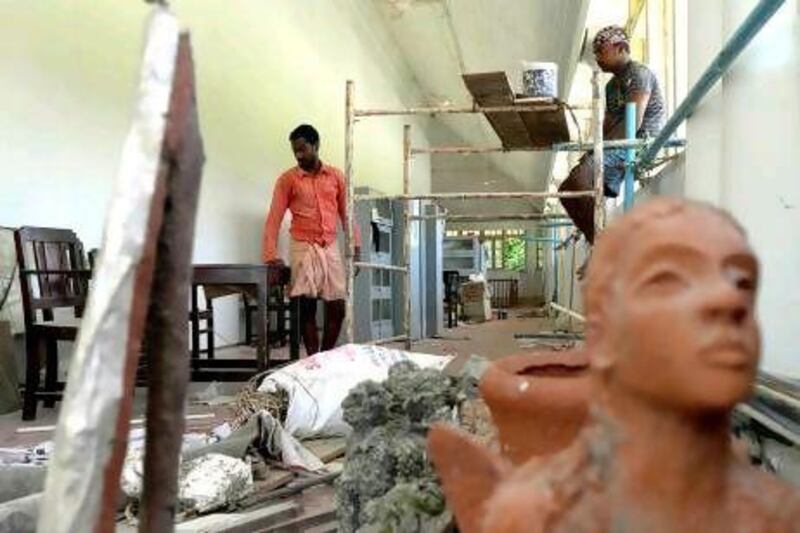Take away the loping palm trees and the searing fish curries, and Kochi in the South Indian state of Kerala could have something of Venice about it.
That may sound a little far-fetched: These waterways are plied by fishermen in canoes wearing umbrella hats, not gondoliers.
But, like the Italian city, Kochi has been a place for cross-cultural interaction stretching back to the ancient world. Its network of islands was a centre for the spice trade, and the first point where Europeans entered India (their legacy remains in its white-walled streets and Portuguese cathedrals). Later this year, the proud people of Kochi will also host their own art biennale - just like the Venetians.
Bose Krishnamachari is one of India's foremost contemporary artists, recognised for his on-canvas collisions of cylindrical colour. He is heading up the first edition of the Kochi-Muziris Biennale with fellow Kerala artist Riyas Komu.
Art biennials take place every two years and the artwork is not for sale. Organisers commission work from participating artists, who submit proposals generally under a shared theme, which then goes on public display.
For the Kochi event, 80 contemporary artists will descend on the city in December. Half are Indian, the rest from around the world. According to its organisers, participating artists will explore the historical crossroad of cultures that is Kochi.
The Department for Cultural Affairs has allowed the biennale to make full use of the city's glorious - if weathered - historical sites. Subodh Gupta, an internationally renowned Indian artist, has already been in town, checking out the exhibition space, and Sudarshan Shetty is en route.
"It's important to have a cultural hub in India and we feel Kochi has that quality," says Krishnamachari. "This is a city with 30 different languages and communities, and a place where the Portuguese, Dutch and British shared culture with us."
Its pluralism is a microcosm of Kerala itself - one of India's most religiously diverse yet harmonious states. The region is keenly active in the arts, hosting the Trivandrum Film Festival and an offshoot of the Hay Literary Festival. Also, a number of India's major contemporary artists hail from this part of the country.
But Krishnamachari recognises a need to keep Kerala artists working in Kerala rather than moving north to the commercial scene in Mumbai and Delhi. "There are no museums or curators, and few galleries here," he says. "Artists leave to study or work so that they can survive.
"We need to make people aware of how a cultural scene can develop around this biennale. We want to push for certain cultural policies, and are interested in making museum spaces," he adds. Essentially, it's about attracting more opportunities for Kerala artists on their home soil.
The most striking element about the biennale has been its support from the government. The Delhi Triennale (an event with a similar concept) has long since floundered. So investing five crore rupees (Dh3.4 million) of government funds into an experimental event raises the bar of India's state-interest in contemporary art. Not to mention a few eyebrows.
"We were well aware that by touching public money, everything would be questioned," says Krishnamachari. The Hindu reported in January that a group of "veteran artists" had cast doubt on the transparency of how these state funds were being spent.
The original investment remains. But the team, for now, has to seek the rest from private channels to bring the biennale to fruition.
According to Krishnamachari, the issue came from a lack of inclusiveness felt by some of Kerala's senior artists. "In the first round of meetings they gave us their blessing but I don't know what went wrong." Now Komu and Krishnamachari are giving presentations throughout Kerala to outline the cultural impact they say the event will have on the country.
Meanwhile, across the strait between Sri Lanka and India, another non-commercial event has found its legs without government money. The Colombo Art Biennale ran for five days in February, and attracted 4,000 visitors.
"Sri Lanka's government didn't really understand the concept," says founding director Annoushka Hempel. "That might change now they've seen it in action."
Colombo hosted a similar event back in 2009, in the bleak aftermath of the civil war. "Imagining Peace" tasked Sri Lanka's artists with reflecting on a future beyond the 30-year conflict.
This time around, they accepted proposals from 42 artists (the majority from Sri Lanka) on the theme of "Becoming": "It was looking at this unknown, almost scary space of transition; one that has tremendous potential," says Hempel.
Her desire to create the biennale came from a disparity between what Sri Lanka's artists were making in their studios and the work being displayed in public. "Being an artist in Sri Lanka is very tough," she says, citing the country's isolation from Asia's wider art scene as a factor. "Artists are forced to paint so as to put food on the table. I wanted to give them the opportunity to show off their creative potential in a non-commercial way."
Herein lies the ultimate benefit of South Asia's new biennales. The commercial art scene in north India may be slowly picking up again since the art bubble burst in 2008 (slow but steady sales at Delhi's Indian Art Fair in January are an indicator). But aside from creating new hubs for art that can engage beyond their borders, this biennale model also offers a non-commercial balance to the scene.
Artists need respite from the pressure of selling their work to private collectors. It keeps things interesting and daring and allows them to really stretch their claws in front of a wider public. It is art for art's sake, refreshingly not for sale.





